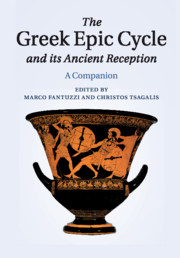Book contents
- Frontmatter
- Contents
- List of illustrations
- List of contributors
- Editorial note
- Introduction: Kyklos, the Epic Cycle and Cyclic poetry
- PART I APPROACHES TO THE EPIC CYCLE
- 1 Coming adrift: The limits of reconstruction of the cyclic poems
- 2 Oral traditions, written texts, and questions of authorship
- 3 The Epic Cycle and oral tradition
- 4 The formation of the Epic Cycle
- 5 Motif and source research: Neoanalysis, Homer, and Cyclic epic
- 6 Meta-Cyclic epic and Homeric poetry
- 7 Language and meter of the Epic Cycle
- 8 Narrative techniques in the Epic Cycle
- 9 Wit and irony in the Epic Cycle
- 10 The Trojan War in early Greek art
- PART II EPICS
- PART III THE FORTUNE OF THE EPIC CYCLE IN THE ANCIENT WORLD
- Works cited
- Index of principal passages
- Index nominum et rerum
6 - Meta-Cyclic epic and Homeric poetry
from PART I - APPROACHES TO THE EPIC CYCLE
Published online by Cambridge University Press: 05 August 2015
- Frontmatter
- Contents
- List of illustrations
- List of contributors
- Editorial note
- Introduction: Kyklos, the Epic Cycle and Cyclic poetry
- PART I APPROACHES TO THE EPIC CYCLE
- 1 Coming adrift: The limits of reconstruction of the cyclic poems
- 2 Oral traditions, written texts, and questions of authorship
- 3 The Epic Cycle and oral tradition
- 4 The formation of the Epic Cycle
- 5 Motif and source research: Neoanalysis, Homer, and Cyclic epic
- 6 Meta-Cyclic epic and Homeric poetry
- 7 Language and meter of the Epic Cycle
- 8 Narrative techniques in the Epic Cycle
- 9 Wit and irony in the Epic Cycle
- 10 The Trojan War in early Greek art
- PART II EPICS
- PART III THE FORTUNE OF THE EPIC CYCLE IN THE ANCIENT WORLD
- Works cited
- Index of principal passages
- Index nominum et rerum
Summary
In recent years, scholars who sought to combine Neoanalytic Quellenforschung with the theory of oral composition have become aware of the fact that Homer uses epic tradition, first and foremost that represented in the poems of the Trojan Cycle, in a rather idiosyncratic way: he does not just evoke the Cycle tradition or borrow its motifs but, rather, deliberately reshapes it, making it serve his own agenda. This strongly suggests that, rather than behaving as two traditional poems among many, the Iliad and Odyssey claimed a special status within the tradition to which they belonged. To render this new awareness as regards the position of Homer vis-à-vis other traditional poetry, the terms ‘metaepic’ and ‘meta-Cyclic’ have been proposed in scholarly literature.
Homer's acknowledgment of the Cycle tradition
It is universally accepted today that the Iliad and Odyssey lean heavily upon the nomenclature of Trojan subjects dealt with in the poems of the Epic Cycle. The recognition of this fact has been one of the major contributions of neoanalysis to Homeric scholarship. At the same time, this should not be taken to mean that, as the pioneers of neoanalysis initially supposed, Homer directly addressed the very poems that were known as ‘Cyclic’ in later periods and that eventually formed the basis of Proclus' summary. The sources on which Homer drew must have belonged to pre-Homeric Trojan tradition of which the poems of the Cycle were post-Homeric representatives. To quote Gregory Nagy, ‘Paradoxically the textual fixation of the Homeric poems is older than that of the Cycle…and yet the inherited themes of the Cycle appear consistently older than those of the Homeric poems.’ The range of the identifiable ‘Cyclic’ subjects to which Homer refers is quite impressive. These references may come either as direct reminiscences of Cyclic episodes (both the Iliad and the Odyssey) or as re-enactments of events narrated in the poems of the Cycle (the Iliad only).
- Type
- Chapter
- Information
- The Greek Epic Cycle and its Ancient ReceptionA Companion, pp. 126 - 138Publisher: Cambridge University PressPrint publication year: 2015
- 5
- Cited by

